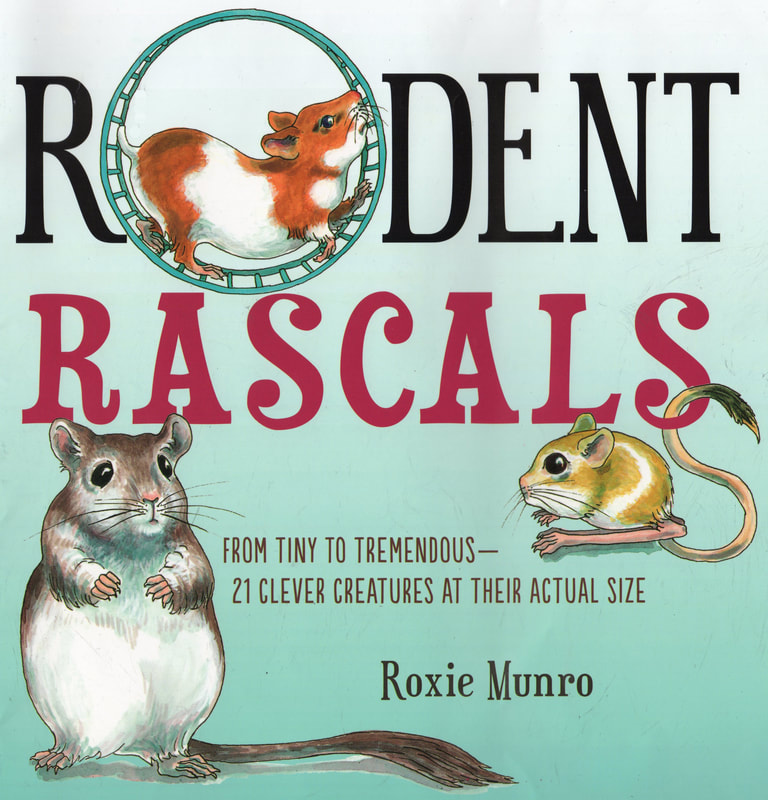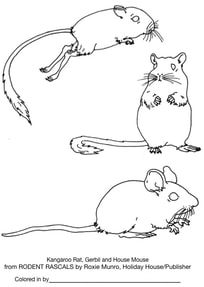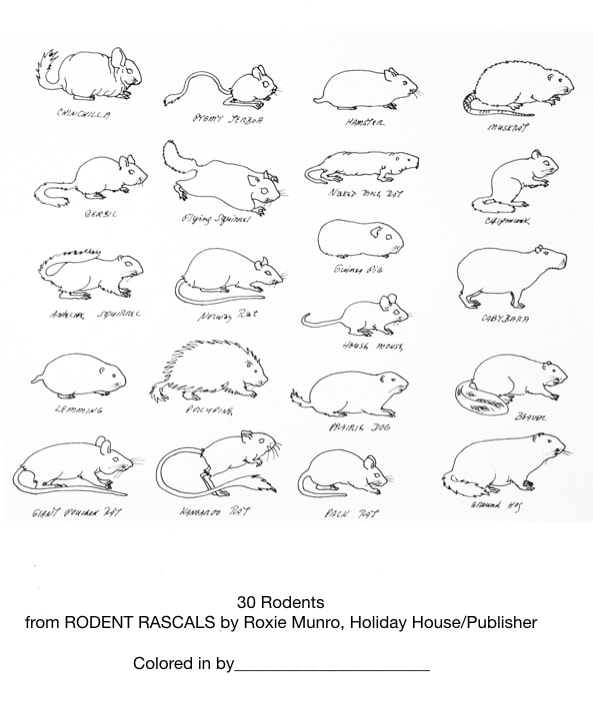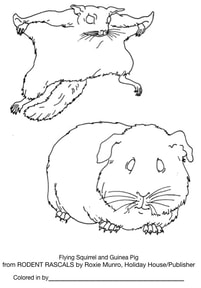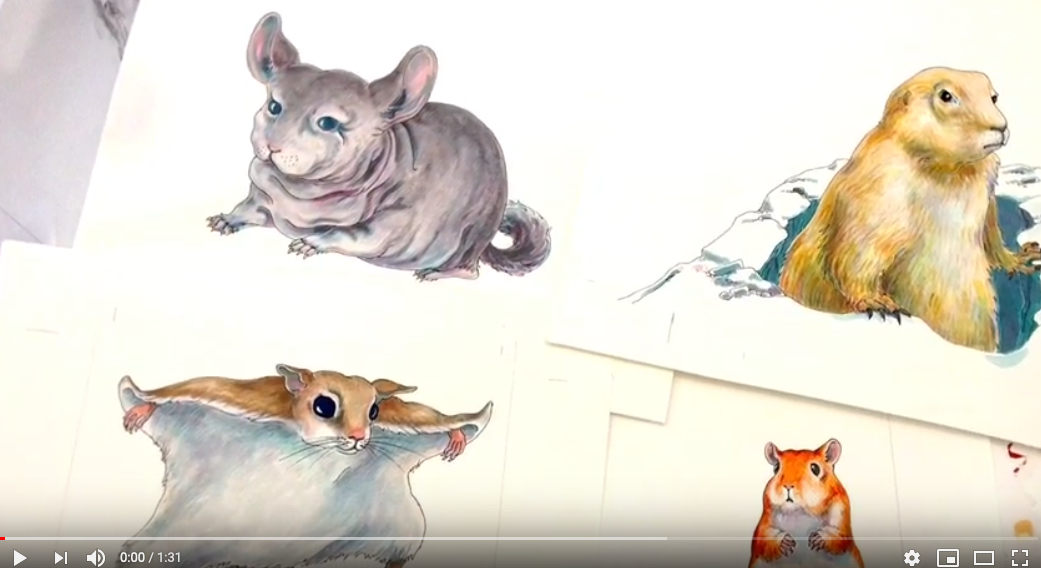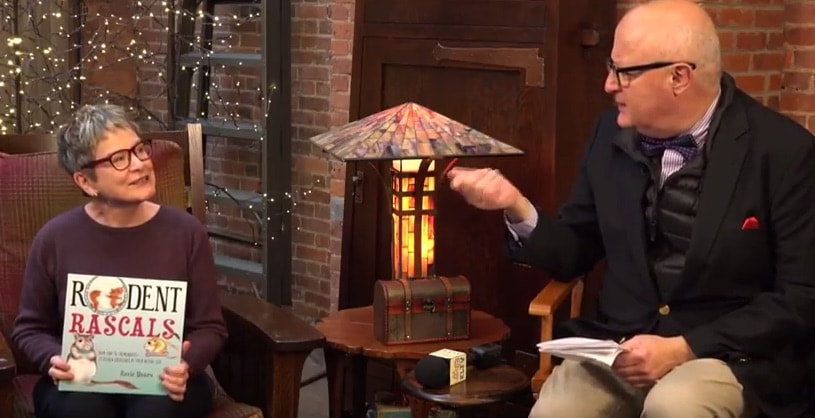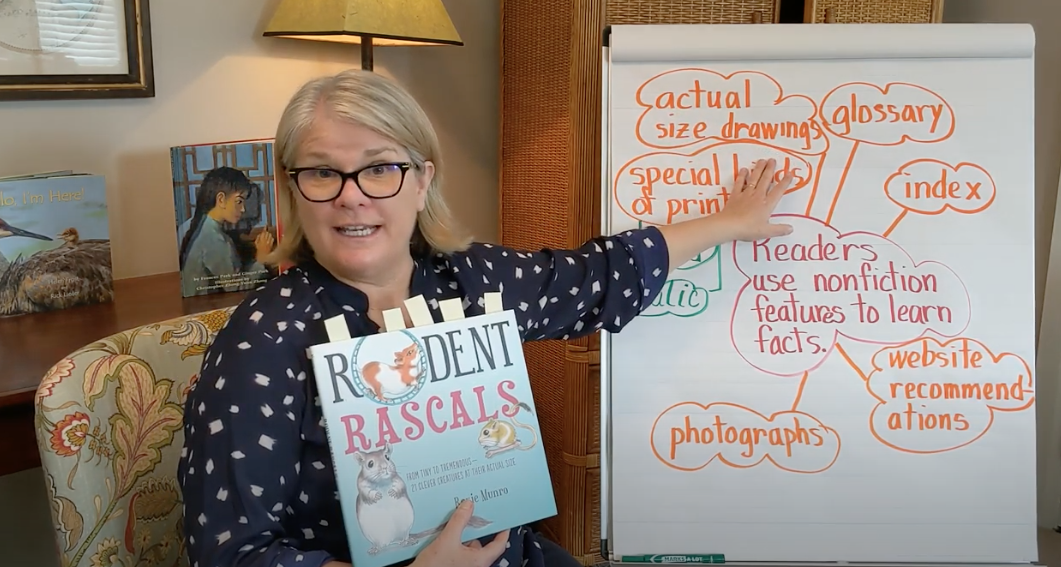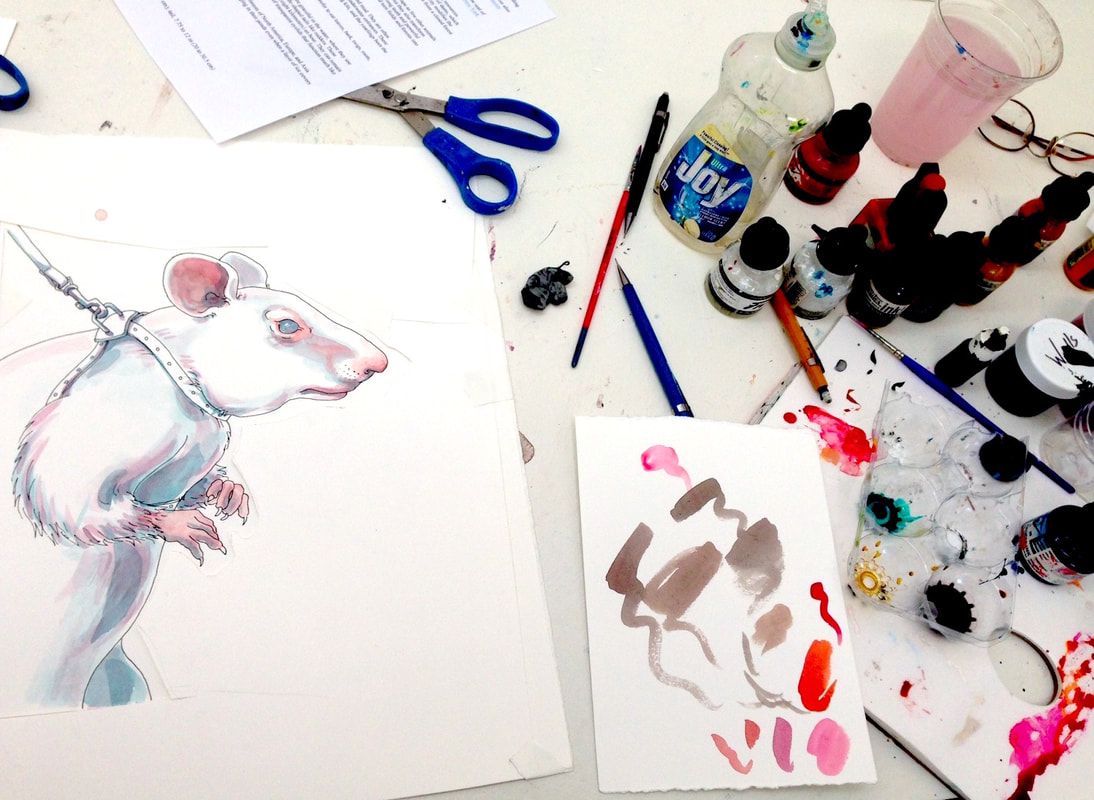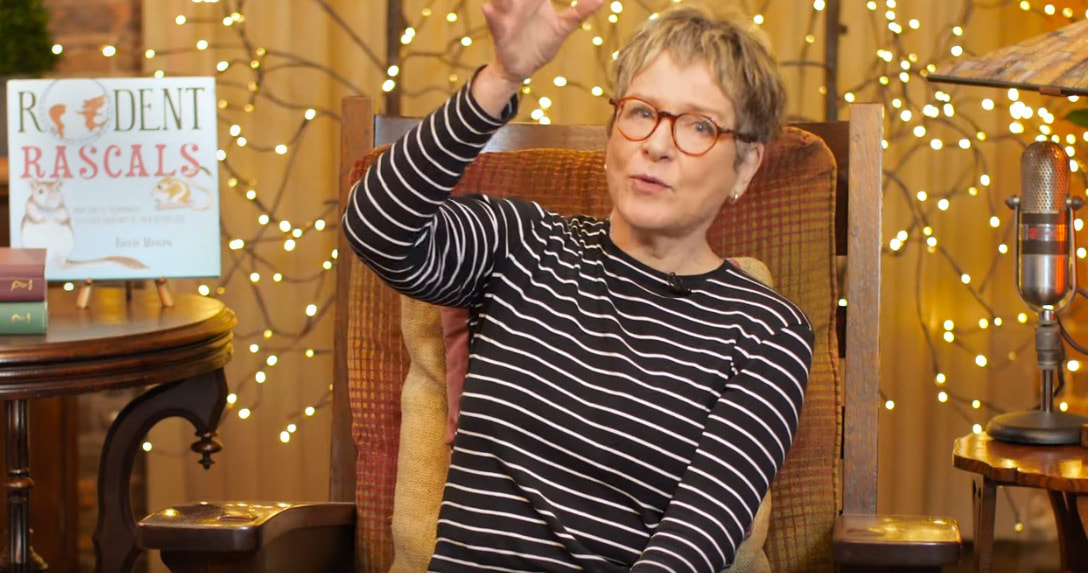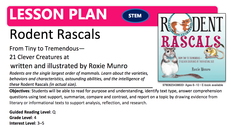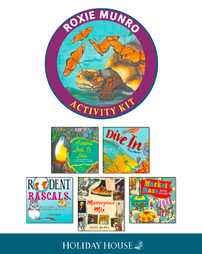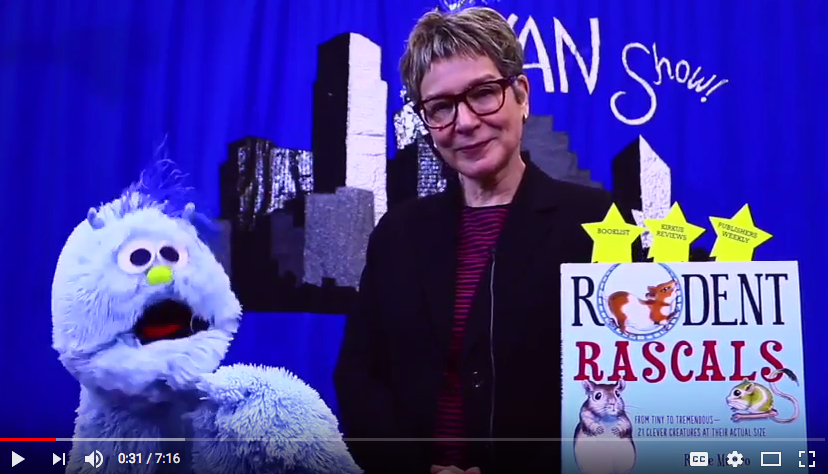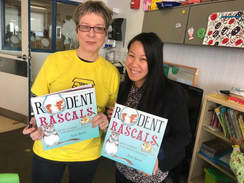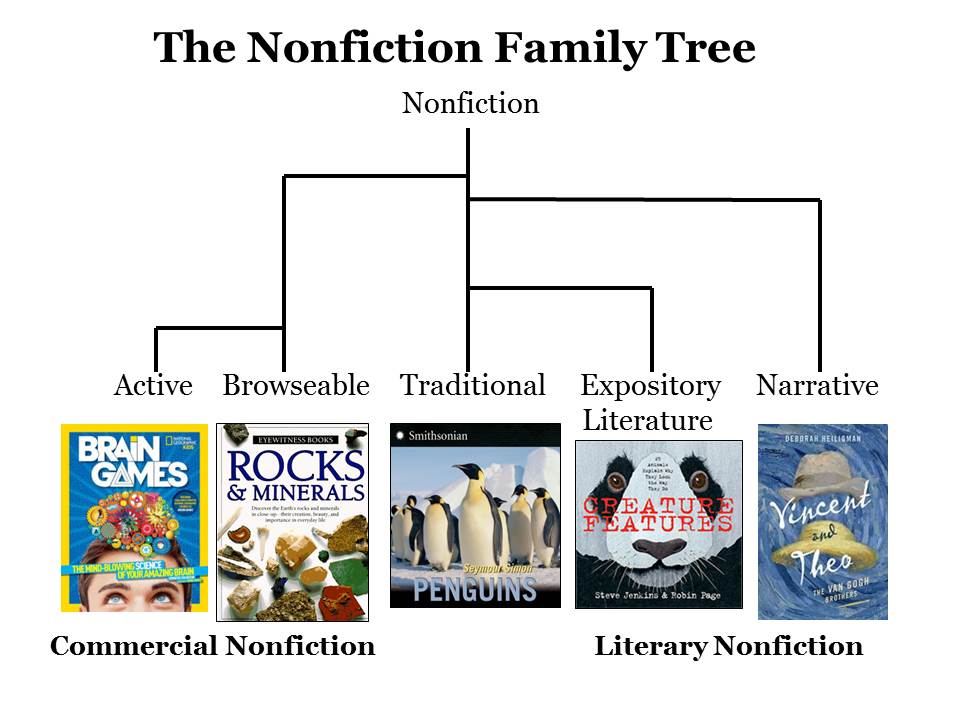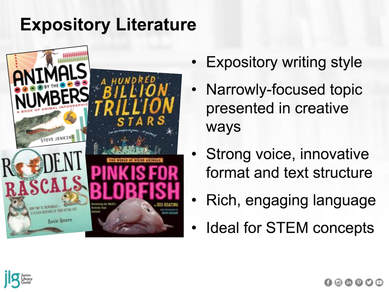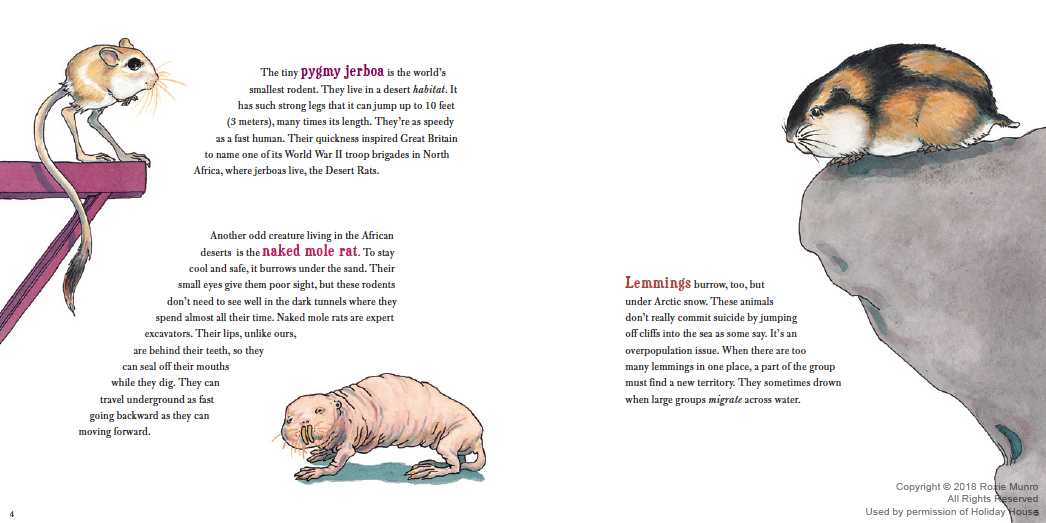Three STARRED reviews!
From Kirkus, Publishers Weekly, and Booklist!
(Scroll down for reviews, images, lesson plans, an online reading, and more...)
From Kirkus, Publishers Weekly, and Booklist!
(Scroll down for reviews, images, lesson plans, an online reading, and more...)
One of Bank Street's Best Books of the Year 2019 for STEM!!!
Here are three FREE coloring pages you can print out !
|
|
| ||||||||||||||||||
|
To check out a really darling, informative, and lively short (90-second) trailer for the book, created by a librarian graduate student,
click on the image on the left or here: https://www.youtube.com/watch?v=LTMw5BHoCTU&feature=youtu.be |
|
To see a fun preview of Rodent Rascals, here's a KidLit TV video with me, the book, and host Rocco Staino on World Read Aloud Day 2018.
Click here: https://www.youtube.com/watch?v=gI8sVQSy1S0&t=11s |
"Rodent Rascals" made the 2022-23 PA Young Readers Choice List for Grades 3-6!
Thank you, Pennsylvania!
Click here: https://pyrcapsla.wixsite.com/pyrca/2022-23-nominated-titles
Thank you, Pennsylvania!
Click here: https://pyrcapsla.wixsite.com/pyrca/2022-23-nominated-titles
|
A teacher does a lovely job reading parts of Rodent Rascals - she also discusses the fun format and design elements and how they work .
Click here: https://www.youtube.com/watch?v=wX_zuU5lf8s |
|
For a short interview with Holiday House on how "Rodent Rascals" came to be,
click here: http://www.holidayhouse.com/featured-artist/ |
|
Working with the Children's Book Council (CBC) , KidLit TV & Every Child A Reader are presenting CREATOR CORNER for Book Week 2020. One hundred authors & illustrators have done short videos (4 or 5 minutes) for children. Here's mine, on "Rodent Rascals":
https://www.youtube.com/watch?v=g2GR3edhulI&feature=youtu.be |
School Library Journal's The Classroom Bookshelf did a wonderful review (scroll down to see it) along with lots of Teacher Activities for PreK-6 grade! Click here for activities as well as the review: http://www.theclassroombookshelf.com/2018/12/rodent-rascals-from-tiny-to-tremendous-21-creatures-at-their-actual-size/
|
For the short Holiday House interview on how the book was made, including fun in-progress pictures (scroll to third page), click the file on right
|
| ||||||
I now have a special brand new program for my School Visits about "Rodent Rascals" and how the book was created....
click here for more: School Visits
click here for more: School Visits
|
For the Lesson Plan created by Holiday House, click on this link: www.holidayhouse.com/docs/Rodent_Rascals_Lesson_Plan.pdf,
or click right to download the pdf... |
| |||||||
|
Holiday House has created a free lively fun-filled Activity Kit for 5 of my books!
Click to download: https://holidayhouse.com/wp-content/uploads/2021/10/Roxie-Munro-activity-kit-des3.pdf |
Email me for free "Rodent Rascals" bookmarks for your library patrons, students, or children: [email protected]
|
Fun video interview with The Van Show by the Austin Public Library at the Texas library Association, about my childhood, career, and "Rodent Rascals"! Click here: https://www.youtube.com/watch?v=7DFgMEfQJkY&feature=youtu.be |
|
CLICK on icon on right to download Judy Freeman's pdf with 3 pages of fun rodent activities and a page of related titles! Scroll down to see Judy's review (below).
|
| ||||||
|
Visiting the children's unit a NYC Hospital for Project Sunshine - signing and reading "Rodent Rascals" to the patients, and wearing the iconic Project Sunshine tee-shirt.
For more information on Project Sunshine, click here. |
|
Well-known NF author Melissa Stewart has a great blog called CELEBRATE SCIENCE (click here: Melissa's blog). Among a lot of interesting content (and related activities), she has developed and discusses five categories of nonfiction (The Nonfiction Family Tree), with Expository Literature being her favorite.
|
Nice to be included in Miss Magee Reads 2018 Mock Orbis list!
Click here: http://missmageesreads.com/2018/07/28/kicking-off-the-2018-mock-orbis-pictus/
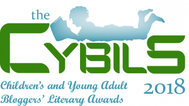
RODENT RASCALS is a CYBILS Award Nominee in Nonfiction!
Click here: http://blog.growingwithscience.com/
...on #Kidlit: Women In STEM
STEM Friday #Kidlit Rodent RascalsLet’s explore another of the fantastic nonfiction children’s books that have been nominated for 2018 Cybils award!
Someone must have squirreled away Rodent Rascals: From Tiny to Tremendous -- 21 Clever Creatures at Their Actual Size by Roxie Munro because it took a long time to get it at the library. The good news is it was worth the wait.
(Scroll down to see entire review and activities)
Click here: http://blog.growingwithscience.com/
...on #Kidlit: Women In STEM
STEM Friday #Kidlit Rodent RascalsLet’s explore another of the fantastic nonfiction children’s books that have been nominated for 2018 Cybils award!
Someone must have squirreled away Rodent Rascals: From Tiny to Tremendous -- 21 Clever Creatures at Their Actual Size by Roxie Munro because it took a long time to get it at the library. The good news is it was worth the wait.
(Scroll down to see entire review and activities)
★RODENT RASCALS [STARRED REVIEW!] from KIRKUS
Pages: 40
Price ( Hardcover ): $17.95
Price ( e-book ): $17.95
Publication Date: February 6, 2018
ISBN ( Hardcover ): 978-0-8234-3860-0
ISBN ( e-book ): 978-0-8234-4074-0
Category: Informational
Twenty-one representatives of the largest mammalian order pose in this fetching portrait gallery. Each one depicted, all or in part, at actual size, the rodentine array begins with a pocket-watch-size African pygmy jerboa and concludes with the largest member of the clan, the "sweet-looking capybara." In between, specimens climb the scale past chipmunks and northern flying squirrels to a Norway rat, porcupine, and groundhog. Despite a few outliers such as the naked mole rat and a rather aggressive-looking beaver, Munro's animals—particularly her impossibly cute guinea pig—strongly exude shaggy, button-eyed appeal. Her subjects may come across as eye candy, but they are drawn with naturalistic exactitude, and in her accompanying descriptive comments, she often relates certain visible features to distinctive habitats and behaviors. She also has a terrific feel for the memorable fact: naked mole rats run as quickly backward in their tunnels as forward; African giant pouched rats have been trained to sniff out mines; the house mouse "is a romantic. A male mouse will sing squeaky love songs to his girlfriend" (that are, fortunately or otherwise, too high for humans to hear). Closing summaries will serve budding naturalists in need of further specifics about sizes, diets, geographical ranges, and the like. "Humans are lucky to have rodents," Munro argues…and makes her case with equal warmth to hearts and minds. (websites, index) (Informational picture book. 7-9)
★ Starred review Booklist!
Did you know there are about 110 species of gerbils? Or that the African giant pouched rat can sniff out dangerous abandoned land mines?
21 amazing rodents with incredible talents and unique features are the focus of this fun and informative title. Each creature is beautifully illustrated in actual size, with soft brushstrokes providing excellent details of the rodents’ fur and hair, nails, and teeth. Informative paragraphs accompany each rodent and provide interesting details about their sizes, homes, talents, and habits. Readers young and old will be amazed at the many different varieties, sizes, and talents described, and will undoubtedly want to seek out further information about the intelligent creatures included as well as those rodents not included in the text. The crisp, clear text will make it easy for readers to follow along, with the names of each rodent presented in large colorful text and italicized words defined in a glossary.
Further detailed informative paragraphs about each featured rodent follow the main illustrated pages, along with a glossary, resources, a list of related websites for readers to explore, and an index.
A fun, unique, andinformative addition to all children’s nonfiction collections.
— Selenia Paz
BEST BOOKS
AUTHORS
PUBLISHERS WEEKLY
Rodent Rascals: From Tiny to Tremendous— 21 Clever Creatures at Their Actual SizeRoxie Munro. Holiday House, $17.95 (40p) ISBN 978-0-8234-3860-0
Writing with warmth and enthusiasm, Munro celebrates the biodiversity of rodents. She introduces 21 rodents in all, ranging from the house mouse to the naked mole rat, and describes each creature with casual wonder: “Bushy-tailed wood rats or pack rats love to collect bright shiny things, such as keys, bottle caps, and jewelry,” and the African giant pouched rat can be trained to sniff out land mines and detect tuberculosis in labs. Because the animals are drawn to scale, readers get a clear sense of their relative sizes. The world’s largest rodent, a capybara, fills a page with its head and nose alone; the smallest, the pygmy jerboa, occupies just a page corner. Munro blends naturalism with a hint of personality for each rodent, accentuating the positive attributes of an underappreciated group of animals. Ages 6–10. (Feb.)
AUTHORS
PUBLISHERS WEEKLY
Rodent Rascals: From Tiny to Tremendous— 21 Clever Creatures at Their Actual SizeRoxie Munro. Holiday House, $17.95 (40p) ISBN 978-0-8234-3860-0
Writing with warmth and enthusiasm, Munro celebrates the biodiversity of rodents. She introduces 21 rodents in all, ranging from the house mouse to the naked mole rat, and describes each creature with casual wonder: “Bushy-tailed wood rats or pack rats love to collect bright shiny things, such as keys, bottle caps, and jewelry,” and the African giant pouched rat can be trained to sniff out land mines and detect tuberculosis in labs. Because the animals are drawn to scale, readers get a clear sense of their relative sizes. The world’s largest rodent, a capybara, fills a page with its head and nose alone; the smallest, the pygmy jerboa, occupies just a page corner. Munro blends naturalism with a hint of personality for each rodent, accentuating the positive attributes of an underappreciated group of animals. Ages 6–10. (Feb.)
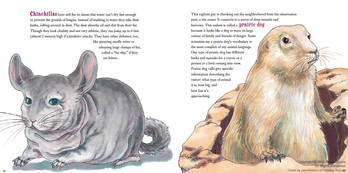
School Library Journal February 2018
MUNRO, Roxie. Rodent Rascals. illus. by Roxie Munro.
40p. bibliog. further reading. glossary.
index. websites.
Holiday House. Feb. 2018. Tr $17.95. ISBN 9780823438600.
Gr 3-5–Munro’s joyful ode to rodents is a refreshing take on these often maligned creatures. The book starts small with the pygmy jerboa and ends big with the capybara. Readers will gain a host of knowledge from the text; the entries on the naked mole rat, prairie dog, and African giant pouched rat contain fascinating information on how these animals survive in their environments or assist humans in complex tasks. The value and cleverness of rodents, particularly as they relate to daily life, are running threads throughout the work. The author also tackles a number of related myths; for example, lemmings “don’t really commit suicide by jumping off cliffs into the sea as some say” but rather migrate when forced to by overpopulation. The artwork, created with India ink and colored acrylic inks on paper, is a pleasure to pore over. Illustrations are drawn to scale and skillfully communicate the rodents’ physical appearance and hint at their temperament, resulting in an inviting and accurate work. The back matter goes into greater depth for each subject, providing scientific names, average sizes, and more.
VERDICT Even the most resistant of readers will fall in love with these rascally rodents. A fine selection for animal collections.–Della Farrell, School Library Journal
In The 2019 Winners Handbook: A Closer Look at Judy
Freeman’s Top-Rated Children’s Books of 2018
By Judy Freeman (bookkrafters, 2019; www.btsb.com)
Think you know lots about rodents? Prepare to be schooled. Roxie Munro, well known for her intricate books of mazes, has an insatiable curiosity for all things factual. This time
she’s taken a fancy to all things rodent, which she defines in the Introduction as “. . . a mammal with a single pair of teeth called incisors in both the upper and lower jaw.” These teeth never stop growing, so rodents have to keep them short and sharp by gnawing on things. Selecting a representative sampling of twenty-one different rodents, she’s compiled an interesting paragraph of facts about each one, accompanied with a most compelling drawing, done in India ink and colored acrylic inks. Best of all, they’re drawn actual size and
arranged by size, from the smallest, the tiny pygmy jerboa from North Africa, the world’s smallest rodent, to the biggest, the capybara from South America.
With each page turn, the rodents get larger and larger; the capybara’s head fills the whole page. Some facts kids will already know; others are surprising. Did you know there are about 110 species of gerbils, including the Indian hairy-footed gerbil? That flying squirrels can’t really fly? (They glide.) That the Norway rat can climb straight up a brick wall or jump off a fifty-foot building unscathed. (Apologies for that fact—I know it won’t make your day to learn this.) That the naked mole rat lives longer than any other rodent? That fact is listed in the back matter which includes an additional paragraph about each rodent. There’s also a glossary, a list of books and websites, and an index.
GERM: Here’s an idea for a fiction versus nonfiction lesson. Have your kids work in pairs or trios to pick a rodent covered in the book and see if they can, first, find more information about it, and then, find an easy fiction/picture book about it. They will need to read the picture book with their partners and determine what rodent facts have been incorporated into the fictional narrative. I’ve listed a batch of my favorites below, but you’ll surely have additional mouse and rat books in your collection. Some of the creatures in Roxie’s book have not been covered before (the pygmy jerboa and chinchilla, for example), so leave them off your list of choices. The kids can write up a paragraph, in their own words, of interesting facts not covered in the original book and present them, along with a show-and-tell display of the fiction book, describing what information was actually true. Go to Roxie’s marvelous website to find videos on how and why she wrote this book, a teacher’s guide, and more about this book (and all her other ones): www.roxiemunro.com/rodent-rascals.html. After you read the book aloud, have kids tackle the “Do You Know These Rodent Rascals?” and the “My Favorite Rodent Is the _____” worksheets in this handbook on pages 196-198.
Freeman’s Top-Rated Children’s Books of 2018
By Judy Freeman (bookkrafters, 2019; www.btsb.com)
Think you know lots about rodents? Prepare to be schooled. Roxie Munro, well known for her intricate books of mazes, has an insatiable curiosity for all things factual. This time
she’s taken a fancy to all things rodent, which she defines in the Introduction as “. . . a mammal with a single pair of teeth called incisors in both the upper and lower jaw.” These teeth never stop growing, so rodents have to keep them short and sharp by gnawing on things. Selecting a representative sampling of twenty-one different rodents, she’s compiled an interesting paragraph of facts about each one, accompanied with a most compelling drawing, done in India ink and colored acrylic inks. Best of all, they’re drawn actual size and
arranged by size, from the smallest, the tiny pygmy jerboa from North Africa, the world’s smallest rodent, to the biggest, the capybara from South America.
With each page turn, the rodents get larger and larger; the capybara’s head fills the whole page. Some facts kids will already know; others are surprising. Did you know there are about 110 species of gerbils, including the Indian hairy-footed gerbil? That flying squirrels can’t really fly? (They glide.) That the Norway rat can climb straight up a brick wall or jump off a fifty-foot building unscathed. (Apologies for that fact—I know it won’t make your day to learn this.) That the naked mole rat lives longer than any other rodent? That fact is listed in the back matter which includes an additional paragraph about each rodent. There’s also a glossary, a list of books and websites, and an index.
GERM: Here’s an idea for a fiction versus nonfiction lesson. Have your kids work in pairs or trios to pick a rodent covered in the book and see if they can, first, find more information about it, and then, find an easy fiction/picture book about it. They will need to read the picture book with their partners and determine what rodent facts have been incorporated into the fictional narrative. I’ve listed a batch of my favorites below, but you’ll surely have additional mouse and rat books in your collection. Some of the creatures in Roxie’s book have not been covered before (the pygmy jerboa and chinchilla, for example), so leave them off your list of choices. The kids can write up a paragraph, in their own words, of interesting facts not covered in the original book and present them, along with a show-and-tell display of the fiction book, describing what information was actually true. Go to Roxie’s marvelous website to find videos on how and why she wrote this book, a teacher’s guide, and more about this book (and all her other ones): www.roxiemunro.com/rodent-rascals.html. After you read the book aloud, have kids tackle the “Do You Know These Rodent Rascals?” and the “My Favorite Rodent Is the _____” worksheets in this handbook on pages 196-198.
|
CLICK on icon on right to download Judy Freeman's pdf with 3 pages of fun rodent activitiy worksheets and a page of related titles!
|
| ||||||
International Literary Association (ILA)
Books Across the Curriculum
By Barbara A. Ward (link: https://literacyworldwide.org/blog/literacy-daily/2018/02/26/books-across-the-curriculum)
Children's and young adult trade books—both fiction and nonfiction—offer avenues through which readers can explore fascinating topics in various content areas. Here is a selection of books with curriculum connections to science and social studies that are sure to entice readers and to foster curiosity and critical thinking.
Ages 9–11
Rodent Rascals. Roxie Munro. 2018. Holiday House.
Although some might describe them as “rascals,” rodents are nonetheless fascinating, as this book demonstrates. With India and acrylic ink illustrations of the 21 featured rodents, Roxie Munro introduces readers to the diverse group of mammals in the order Rodentia, which vary in size, shape, behavioral characteristics, and habitat. Moving from diminutive to massive, the book begins with the small pygmy jerboa and concludes with the capybara, the world's largest rodent. Along the way, readers will learn interesting facts about rodents, such as how one rodent—the earth-tunneling naked mole rat—has lips behind its teeth. Another, the African giant pouched rat, has such a well-developed sense of smell that it can search out explosives and detect tuberculosis. Readers will finish the book with a different perspective on rodents.
Books Across the Curriculum
By Barbara A. Ward (link: https://literacyworldwide.org/blog/literacy-daily/2018/02/26/books-across-the-curriculum)
Children's and young adult trade books—both fiction and nonfiction—offer avenues through which readers can explore fascinating topics in various content areas. Here is a selection of books with curriculum connections to science and social studies that are sure to entice readers and to foster curiosity and critical thinking.
Ages 9–11
Rodent Rascals. Roxie Munro. 2018. Holiday House.
Although some might describe them as “rascals,” rodents are nonetheless fascinating, as this book demonstrates. With India and acrylic ink illustrations of the 21 featured rodents, Roxie Munro introduces readers to the diverse group of mammals in the order Rodentia, which vary in size, shape, behavioral characteristics, and habitat. Moving from diminutive to massive, the book begins with the small pygmy jerboa and concludes with the capybara, the world's largest rodent. Along the way, readers will learn interesting facts about rodents, such as how one rodent—the earth-tunneling naked mole rat—has lips behind its teeth. Another, the African giant pouched rat, has such a well-developed sense of smell that it can search out explosives and detect tuberculosis. Readers will finish the book with a different perspective on rodents.
School Library Journal THE CLASSROOM BOOKSHELF
Rodent Rascals: From Tiny to Tremendous – 21 Creatures at Their Actual SizeDecember 4, 2018 by Erika Thulin Dawes A superhero rat who can scale buildings and chew through cement; a capybara as a seeing-eye guide animal; rats trained to detect landmines and Tuberculosis – these fascinating rodents and 18 more are the subject of author/illustrator Roxie Munroe’s latest picture book. Opening with an introduction that will make many readers squirm, Monroe defines the classification: “A rodent is a mammal with a single pair of teeth called incisors in both the upper and lower jaw.” Elaborating on their variety (lifestyles, size, location and characteristics), she makes the claim that rodents improve the quality of human life. They have served as research tools, sources of fur, pets, and even food! Monroe then presents 21 rodents, using short expository text segments to describe interesting characteristics and unique behaviors. To bring this array of rats, squirrels, mice, guinea pigs, capybaras, etc. to life, Monroe depicts the rodents at their actual size (perhaps taking a cue from Steve Jenkins’s innovative book Actual Size). Rendered in ink and acrylic, the animals inhabit white space on the page. Some, like the groundhog and the African giant pouched rat exceed the boundaries of the trim size and thus, span a page turn. Munroe’s helpful back matter includes specific size information for each featured rodent along with supplemental facts. Readers will appreciate the glossary, sources, and recommended websites. Equally cute, cringe-worthy, and curiosity-inspiring, this title won’t stay long on your shelves. Excellent for units on animal characteristics and as a model for expository writing, Rodent Rascals will entertain and inform.
Teaching Ideas: Invitations for Your Classroom
Click here: http://www.theclassroombookshelf.com/2018/12/rodent-rascals-from-tiny-to-tremendous-21-creatures-at-their-actual-size/
Rodent Rascals: From Tiny to Tremendous – 21 Creatures at Their Actual SizeDecember 4, 2018 by Erika Thulin Dawes A superhero rat who can scale buildings and chew through cement; a capybara as a seeing-eye guide animal; rats trained to detect landmines and Tuberculosis – these fascinating rodents and 18 more are the subject of author/illustrator Roxie Munroe’s latest picture book. Opening with an introduction that will make many readers squirm, Monroe defines the classification: “A rodent is a mammal with a single pair of teeth called incisors in both the upper and lower jaw.” Elaborating on their variety (lifestyles, size, location and characteristics), she makes the claim that rodents improve the quality of human life. They have served as research tools, sources of fur, pets, and even food! Monroe then presents 21 rodents, using short expository text segments to describe interesting characteristics and unique behaviors. To bring this array of rats, squirrels, mice, guinea pigs, capybaras, etc. to life, Monroe depicts the rodents at their actual size (perhaps taking a cue from Steve Jenkins’s innovative book Actual Size). Rendered in ink and acrylic, the animals inhabit white space on the page. Some, like the groundhog and the African giant pouched rat exceed the boundaries of the trim size and thus, span a page turn. Munroe’s helpful back matter includes specific size information for each featured rodent along with supplemental facts. Readers will appreciate the glossary, sources, and recommended websites. Equally cute, cringe-worthy, and curiosity-inspiring, this title won’t stay long on your shelves. Excellent for units on animal characteristics and as a model for expository writing, Rodent Rascals will entertain and inform.
Teaching Ideas: Invitations for Your Classroom
Click here: http://www.theclassroombookshelf.com/2018/12/rodent-rascals-from-tiny-to-tremendous-21-creatures-at-their-actual-size/
JEAN LITTLE LIBRARY BLOG
I feel like Munro isn't very well-known in the easy nonfiction genre, but I have quite a few kids who enjoy her books. They work well across age groups and this new title is a favorite for us, due to our library gerbils.
Each animal gets a life-size picture, starting small with the pygmy jerboa and working all the way up to the snooty nose of a capybara, all that fits on the page. As the animals get larger, they start stretching across pages, like the beaver whose tail is on one spread and the rest is on the following pages. The rodents are shown in motion, running on wheels, nibbling snacks, or just posed against the bold white backgrounds. Each has a paragraph of description to themselves, listing their unique qualities. Readers will learn that the male house mouse sings to his mate, about famous groundhog Punxsutawney Phil, and about the unique sounds made by a capybara. White outlines of the various rodents are shown on the endpages (not to scale) and there is a detailed introduction, additional information on each animal, glossary, sources, suggested websites, and index in the back.
Verdict: A great introduction to this oft-maligned family of animals, this book is sure to intrigue rodent-lovers and pique their interest. It can work as a read-aloud, and young children will enjoy looking at the pictures, but it is better suited to browsing and research by 2nd to 3rd graders in my opinion.
Each animal gets a life-size picture, starting small with the pygmy jerboa and working all the way up to the snooty nose of a capybara, all that fits on the page. As the animals get larger, they start stretching across pages, like the beaver whose tail is on one spread and the rest is on the following pages. The rodents are shown in motion, running on wheels, nibbling snacks, or just posed against the bold white backgrounds. Each has a paragraph of description to themselves, listing their unique qualities. Readers will learn that the male house mouse sings to his mate, about famous groundhog Punxsutawney Phil, and about the unique sounds made by a capybara. White outlines of the various rodents are shown on the endpages (not to scale) and there is a detailed introduction, additional information on each animal, glossary, sources, suggested websites, and index in the back.
Verdict: A great introduction to this oft-maligned family of animals, this book is sure to intrigue rodent-lovers and pique their interest. It can work as a read-aloud, and young children will enjoy looking at the pictures, but it is better suited to browsing and research by 2nd to 3rd graders in my opinion.
Vicki Cobb (science writer and teacher) , reviewer; Founder of iNK Think Tank
Link: https://www.vickicobbsblog.com/blog/dont-say-eek-say-how-interesting
Link: https://www.vickicobbsblog.com/blog/dont-say-eek-say-how-interesting
Don't say "Eek!," Say How interesting!
Most people think of rats and mice as animals with really bad reputations. After all, many live in filthy areas where we wouldn’t want to go. They've been known to carry fleas that were vectors of disease. However, according to Roxie Munro, author/illustrator of a glorious picture book called Rodent Rascals, we are lucky to have them. Yes, rats are our friends. They come in all sizes and shapes and have been used by humans as a source of fur, food, pets, and laboratory subjects. What makes them a distinctive order of mammals? They all have a set of front teeth, called incisors, that never stop growing and make rodents capable of gnawing through some of the toughest materials around. Their constant nibbling wears the teeth down to a manageable size and allows them to build dams, drink wine (probably out of oaken vats, in which they’ve made a hole), hollow tunnels and crack acorns, among other marvelous tasks.
Munro’s book is a collection of rodent stars selected by size from the smallest—the pygmy jerboa-who can be up to two inches—to the largest—the greater capybara of South America—who weighs in at 150 pounds. She has drawn her collection at actual size, so all you see of the capybara is its head and its back leg on the previous page. As far as the “rascally” part, Munro gives us the most endearing traits of each selection to impress us with their cleverness, their survival skills, and their value to us. (Did you know there is a rat that has been trained to help electricians by carrying wires through small spaces?)
The value of this beautiful, informative picture book is as a survey of what exists so it can whet the reader’s appetite for more information. In the back matter of the book, you do learn more about the specific size of each rodent and more of its amazing abilities. These snippets of information make the subjects even more intriguing. If this is the first book a child (or even an adult) reads about rodents, it will not be the last. Munro's rodents have such appealing personalities. You might even add a new affectionate family member with soft fur and bright eyes and a deep understanding of the rat race.
Most people think of rats and mice as animals with really bad reputations. After all, many live in filthy areas where we wouldn’t want to go. They've been known to carry fleas that were vectors of disease. However, according to Roxie Munro, author/illustrator of a glorious picture book called Rodent Rascals, we are lucky to have them. Yes, rats are our friends. They come in all sizes and shapes and have been used by humans as a source of fur, food, pets, and laboratory subjects. What makes them a distinctive order of mammals? They all have a set of front teeth, called incisors, that never stop growing and make rodents capable of gnawing through some of the toughest materials around. Their constant nibbling wears the teeth down to a manageable size and allows them to build dams, drink wine (probably out of oaken vats, in which they’ve made a hole), hollow tunnels and crack acorns, among other marvelous tasks.
Munro’s book is a collection of rodent stars selected by size from the smallest—the pygmy jerboa-who can be up to two inches—to the largest—the greater capybara of South America—who weighs in at 150 pounds. She has drawn her collection at actual size, so all you see of the capybara is its head and its back leg on the previous page. As far as the “rascally” part, Munro gives us the most endearing traits of each selection to impress us with their cleverness, their survival skills, and their value to us. (Did you know there is a rat that has been trained to help electricians by carrying wires through small spaces?)
The value of this beautiful, informative picture book is as a survey of what exists so it can whet the reader’s appetite for more information. In the back matter of the book, you do learn more about the specific size of each rodent and more of its amazing abilities. These snippets of information make the subjects even more intriguing. If this is the first book a child (or even an adult) reads about rodents, it will not be the last. Munro's rodents have such appealing personalities. You might even add a new affectionate family member with soft fur and bright eyes and a deep understanding of the rat race.
Reading Style Guide (Jan 30, 2018)
Click here for review: https://www.readingstyle.net/blog/size-wise
"Size Wise"
Rodent Rascals instantly captures attention with a cover showcasing a trio of adorable little critters. The subtext reveals that this picture book contains a selection of astonishing facts about some relatively small mammals, all of them rodents. I could reasonably identify the hamster and the gerbil featured on the cover. However, I wondered about the creature with humongous protruding eyes, strangely long tail, and folded legs which appear longer that its entire body? I puzzled: What is that animal? I wanted to find out more.
I was also captivated by the "actual size" concept. How would Roxie Munro illustrate a book of animals showing true-to-life dimensions within a book approximately 10 1/4 inches wide? I imagined all kinds of possibilities.
I couldn't wait to discover how she accomplishes this feat.
This collection of fascinating rodents is arranged by size, beginning with the smallest. I found the answer to my first question on page one. The pygmy jerboa is the world's smallest rodent and possesses extremely long legs. The 1-inch leg and 1/2-inch foot can jump up to 10 feet! Yes indeed. I had my ruler with me, measuring these furry creatures as I moved through the pages. Each image is accompanied by a paragraph of fascinating trivia, not the boring stuff, but the information that kids love to memorize and rattle off. Did you know that chipmunks can collect as many as 165 acorns a day to store for the winter? How about an African giant pouched rat that detect tuberculosis lab samples with a "higher accuracy rate in ten minutes than a human technician can in a whole day." This is the stuff that young trivia enthusiasts thrive on.
Moving on to my second question: How to depict all these animals at actual size? The very clever Munro figured out a way. As the animals become progressively larger, we see parts of the animals, the beavers' webbed feet, a close-up of the capybara head in profile. Each body part is presented at an authentic size.
Readers will want to spend time poring over these pages. Munro manages to give each animal a distinct charm and character without sacrificing anatomical accuracy. For readers like me who have lived a life filled with hamsters and guinea pigs, this book will bring fond memories. The guinea pig has an uncanny resemblance to a class pet named Daphne. I could almost hear her sweet little squeak. For those who have are fascinated by flying squirrels and naked mole rats, this is the book for you. Rodent Rascals is a novel and engaging way to approach nonfiction.
Back matter includes a brief description of each animal pictured with scientific species and genus name for most, body measurements, habitat, and an interesting fact or two. Additional general information consists of a glossary, an index, and a list of sources and websites.
Archimedes Notebook
I always love opening the covers of a new Roxie Munro book because I know I'll learn something new. Rodent Rascals lives up to that expectation. And yes, she does present them in "actual size" - from the tiniest pygmy jerboa to the sweet-looking capybara. Though, as you can understand, as the rascals get larger the illustration can only capture part of them.
"Humans are lucky to have rodents," Roxie writes. Throughout history, humans have used them as lab rats, fur sources, pets, and food. We've even sent them into space.
Did you know that male house mice sing love songs to their true loves? That flying squirrels don't really fly (they glide), and that there are more than 100 species of gerbils? And that rats have excellent memories? I'm pretty sure the mice in my house do, too, as they always seem to find my chocolate stash. Some rodents have highly developed societies, too. Back matter includes more information about the species highlighted in the book, a glossary, sources for more information, websites, and an index so you can get back to specific critters that you meant to page-mark with sticky notes but forgot.
I always love opening the covers of a new Roxie Munro book because I know I'll learn something new. Rodent Rascals lives up to that expectation. And yes, she does present them in "actual size" - from the tiniest pygmy jerboa to the sweet-looking capybara. Though, as you can understand, as the rascals get larger the illustration can only capture part of them.
"Humans are lucky to have rodents," Roxie writes. Throughout history, humans have used them as lab rats, fur sources, pets, and food. We've even sent them into space.
Did you know that male house mice sing love songs to their true loves? That flying squirrels don't really fly (they glide), and that there are more than 100 species of gerbils? And that rats have excellent memories? I'm pretty sure the mice in my house do, too, as they always seem to find my chocolate stash. Some rodents have highly developed societies, too. Back matter includes more information about the species highlighted in the book, a glossary, sources for more information, websites, and an index so you can get back to specific critters that you meant to page-mark with sticky notes but forgot.
The Fairview Review
From the tiniest pygmy jerboa to the large capybara, Rodent Rascals looks at the amazing world of rodents both near and far. Creatures on every continent except Antarctica show amazing adaptations to their environments. Some can jump 9 or even 10 feet, others can glide through the air or build watertight homes. Read to discover which has an unusual tail that helps it to swim, or which is clever enough to use "heat dumping" to keep itself cool in the desert. Find out which are used to help locate landmines, detect tuberculosis, or predict when spring will come - or which might be responsible for damaging the wiring of a car's engine. Some are kept as pets or lab animals, while others live in the wild or may be found in zoos.
Young readers will be amazed to see each animal represented in life size, making it easy to compare them. Some of the larger animals are shown in part with just a head on one page and maybe a tail or leg shown on another, because they are too big to fit in the book as a whole image. A hamster is shown getting a workout on its exercise wheel while a prairie dog keeps a lookout for anything approaching the colony. Many of the rodents seem to have personality shining out from the page. The gerbil seems startled as if readers have interrupted him while he was busy, while the chipmunk stares over the top of the peanut he is eating as if to say, "What are you looking at?"
Back matter includes details about each species shown - size, habitat, and interesting facts about whether they hibernate, are nocturnal, live in family groups, etc. There is also a glossary, list of sources, and index. An entire page of useful websites are organized into sections about rodents in the wild, in zoos, as pets, and for rodent enthusiasts.
If you know an animal lover, or someone who is especially interested in small furry critters, this is a great book for them. It will make an excellent addition to classroom or school libraries, or to use in lessons on adaptations and the variety of mammals in the world.
I read an F&G provided by the publisher for review purposes.
From the tiniest pygmy jerboa to the large capybara, Rodent Rascals looks at the amazing world of rodents both near and far. Creatures on every continent except Antarctica show amazing adaptations to their environments. Some can jump 9 or even 10 feet, others can glide through the air or build watertight homes. Read to discover which has an unusual tail that helps it to swim, or which is clever enough to use "heat dumping" to keep itself cool in the desert. Find out which are used to help locate landmines, detect tuberculosis, or predict when spring will come - or which might be responsible for damaging the wiring of a car's engine. Some are kept as pets or lab animals, while others live in the wild or may be found in zoos.
Young readers will be amazed to see each animal represented in life size, making it easy to compare them. Some of the larger animals are shown in part with just a head on one page and maybe a tail or leg shown on another, because they are too big to fit in the book as a whole image. A hamster is shown getting a workout on its exercise wheel while a prairie dog keeps a lookout for anything approaching the colony. Many of the rodents seem to have personality shining out from the page. The gerbil seems startled as if readers have interrupted him while he was busy, while the chipmunk stares over the top of the peanut he is eating as if to say, "What are you looking at?"
Back matter includes details about each species shown - size, habitat, and interesting facts about whether they hibernate, are nocturnal, live in family groups, etc. There is also a glossary, list of sources, and index. An entire page of useful websites are organized into sections about rodents in the wild, in zoos, as pets, and for rodent enthusiasts.
If you know an animal lover, or someone who is especially interested in small furry critters, this is a great book for them. It will make an excellent addition to classroom or school libraries, or to use in lessons on adaptations and the variety of mammals in the world.
I read an F&G provided by the publisher for review purposes.
Sal's Fiction Addiction
Rodent Rascals: From Tiny to Tremendous - 21 Clever Creatures at Their Actual Size. Written and illustrated by Roxie Munro. Holiday House, Thomas Allen & Son. 2018. $25.99 ages 8 and up
"Chinchillas have soft fur so dense that water can't dry fast enough to prevent the growth of fungus. Instead of washing in water they take dust baths, rolling around in dust. The dust absorbs oil and dirt from their fur. Though they look chubby and not very athletic, they can jump up to 6 feet high ... "
Kids will be poring over the information provided in this impressive new book by a respected and well-known author. Roxie Munro has written over forty concept and nonfiction books that have the power to attract and fully engage her young audience.
As you can see on the cover, there are 21 rodents described here. Each one is shown in actual size, whether you can see the whole animal or only part of it. She begins with the smallest:
"The tiny pygmy jerboa is the world's smallest rodent. They live in a desert habitat. It has such strong legs that it can jump up to 10 feet (3 meters), many times its length. They're as speedy as a fast human. Their quickness inspired Great Britain to name one of its World War II troop brigades in Northern Africa, where jerboas live, the Desert Rats."
She goes on to describe, in similar sized entries, a host of animals that run the gamut from the jerboa to - can you guess the largest one?
"This sweet-looking capybara is the largest rodent in the world. It lives in South America and is a gentle and friendly creature. It is a herbivore. It can be kept as a pet and has reportedly been trained as a seeing-eye guide animal for the blind. Capybaras are very social and live in large groups. They're quite vocal and can make sounds similar to a dog's bark, a horse's whinny, and a cat's purr. Capybaras love water, and as you can see, their eyes, ears, and nose are high up on their head, so they can stay almost totally submerged while swimming."
With just enough text to keep readers interested and learning, this book will find avid fans. Readers will recognize many of those depicted, although they may not know how they stack up one to the other in size within the rodent family. Natural and distinct, Ms. Munro's illustrations are sure to impress. The way she relates her animals to the text is perfect for helping readers retain what they want to share with others.
Did you know that the prairie dog has a vocabulary more complex than any other animal language?
Or that the African giant pouched rat can detect tuberculosis?
Or that many guinea pigs have a 'washcloth' (bald spot) on their front paws to help with grooming?
I didn't, but now I do! Thanks to Roxie Munro for that and so much more!
Endpapers (with images of the rodents described herein), an introduction, and back matter that includes a further informative paragraph about each animal, a glossary, sources, and an extended list of websites and an index make this perfect nonfiction fare.
Please enjoy this conversation between Ms. Munro and the dapper and well-prepared Julian, a child reporter.
https://youtu.be/Wc5Bcni6onE
Rodent Rascals: From Tiny to Tremendous - 21 Clever Creatures at Their Actual Size. Written and illustrated by Roxie Munro. Holiday House, Thomas Allen & Son. 2018. $25.99 ages 8 and up
"Chinchillas have soft fur so dense that water can't dry fast enough to prevent the growth of fungus. Instead of washing in water they take dust baths, rolling around in dust. The dust absorbs oil and dirt from their fur. Though they look chubby and not very athletic, they can jump up to 6 feet high ... "
Kids will be poring over the information provided in this impressive new book by a respected and well-known author. Roxie Munro has written over forty concept and nonfiction books that have the power to attract and fully engage her young audience.
As you can see on the cover, there are 21 rodents described here. Each one is shown in actual size, whether you can see the whole animal or only part of it. She begins with the smallest:
"The tiny pygmy jerboa is the world's smallest rodent. They live in a desert habitat. It has such strong legs that it can jump up to 10 feet (3 meters), many times its length. They're as speedy as a fast human. Their quickness inspired Great Britain to name one of its World War II troop brigades in Northern Africa, where jerboas live, the Desert Rats."
She goes on to describe, in similar sized entries, a host of animals that run the gamut from the jerboa to - can you guess the largest one?
"This sweet-looking capybara is the largest rodent in the world. It lives in South America and is a gentle and friendly creature. It is a herbivore. It can be kept as a pet and has reportedly been trained as a seeing-eye guide animal for the blind. Capybaras are very social and live in large groups. They're quite vocal and can make sounds similar to a dog's bark, a horse's whinny, and a cat's purr. Capybaras love water, and as you can see, their eyes, ears, and nose are high up on their head, so they can stay almost totally submerged while swimming."
With just enough text to keep readers interested and learning, this book will find avid fans. Readers will recognize many of those depicted, although they may not know how they stack up one to the other in size within the rodent family. Natural and distinct, Ms. Munro's illustrations are sure to impress. The way she relates her animals to the text is perfect for helping readers retain what they want to share with others.
Did you know that the prairie dog has a vocabulary more complex than any other animal language?
Or that the African giant pouched rat can detect tuberculosis?
Or that many guinea pigs have a 'washcloth' (bald spot) on their front paws to help with grooming?
I didn't, but now I do! Thanks to Roxie Munro for that and so much more!
Endpapers (with images of the rodents described herein), an introduction, and back matter that includes a further informative paragraph about each animal, a glossary, sources, and an extended list of websites and an index make this perfect nonfiction fare.
Please enjoy this conversation between Ms. Munro and the dapper and well-prepared Julian, a child reporter.
https://youtu.be/Wc5Bcni6onE
KISS THE BOOK
Get acquainted with members of the rodent family! So many different furry friends are waiting to meet you as you learn all about their life cycles, habitats, and unique qualities.
Life-sized illustrations accompany a book overflowing with facts about the rodent world. Young readers who are interested in animals and want to learn more about rats, guinea pigs, capybaras, and more will be endlessly entertained.
EL (K-3), EL—ADVISABLE. AEB
From the GOOD ANIMALS blog
Click here for review with images (scroll down a bit):
https://good-animals.com/rodents/sorting-rats-and-cats/79680/
Finally, this riveting catalogue of one particular order of mammals, the rodent family.
They range in size from the smallest-of-allest, the pygmy jerboa, a wee desert dweller who can leap fabulous lengths, to the bulkiest beastie, the capybara, weighing in at up to 150 pounds
Munro manages to draw 21 of these guys for us, at life size. For some, their great girth means that not all of them actually fits on any one page, mind you! The layouts are oh-so-clever. Just a brief tease of information accompanies each one, where you’ll find out tantalizing trivia such as that the naked mole rat’s lips are behind his teeth! Which seals off his mouth from the dirt as he expertly excavates his tunnels.
A bit more info on each of these fascinating creatures is added to the back, and Munro’s lengthy introduction is jam-packed with cool rodent info as well, so don’t skip it! This is just the kind of book my son would have gobbled up as a young boy. Brilliant, enticing us to keep on being curious about a worldful of wonders, for ages 6 and up.
Click here for review with images (scroll down a bit):
https://good-animals.com/rodents/sorting-rats-and-cats/79680/
Finally, this riveting catalogue of one particular order of mammals, the rodent family.
They range in size from the smallest-of-allest, the pygmy jerboa, a wee desert dweller who can leap fabulous lengths, to the bulkiest beastie, the capybara, weighing in at up to 150 pounds
Munro manages to draw 21 of these guys for us, at life size. For some, their great girth means that not all of them actually fits on any one page, mind you! The layouts are oh-so-clever. Just a brief tease of information accompanies each one, where you’ll find out tantalizing trivia such as that the naked mole rat’s lips are behind his teeth! Which seals off his mouth from the dirt as he expertly excavates his tunnels.
A bit more info on each of these fascinating creatures is added to the back, and Munro’s lengthy introduction is jam-packed with cool rodent info as well, so don’t skip it! This is just the kind of book my son would have gobbled up as a young boy. Brilliant, enticing us to keep on being curious about a worldful of wonders, for ages 6 and up.
on #Kidlit: Women In STEM
STEM Friday #Kidlit Rodent Rascals
Let’s explore another of the fantastic nonfiction children’s books that have been nominated for 2018 Cybils award!
Someone must have squirreled away Rodent RascalsOpens : From Tiny to Tremendous -- 21 Clever Creatures at Their Actual Size by Roxie Munro because it took a long time to get it at the library. The good news is it was worth the wait.
What are rodents? Munro lets the reader know right in the Introduction. Named for the Latin verb rodere = to gnaw, members of the order Rodentia are furry mammals that are defined by having a single pair of long incisors on their upper and lower jaws that continue to grow throughout their lifetimes.
The rest of the book goes on to explore rodent diversity. The author/illustrator features examples ranging from the tiny pygmy jerboa to the large dog-sized capybara, all of which are drawn with India inks and colored acrylic inks at life size. Accompanying each illustration is a detailed discussion of the history and biology of each kind of rodent. Although this looks like a picture book, the text is written at a high level and Rodent Rascals has been placed in the middle grade category for the Cybils contest.
People have a divided relationship with rodents. One of my relatives hates both mice and squirrels because they steal bird food and chew wiring. He spends his free time devising traps and barriers to exclude them. Our family is on the opposite end of the spectrum because we've enjoyed having several different kinds of rodents as pets. Rodent Rascals is likely to enthrall children who already appreciate rodents and possibly entice a few more skeptical readers to join their ranks. Scurry on out and get a copy today!
Activity Suggestions:
1. Explore the diversity of rodentsResearch the life styles of different rodents, both those kept as pets and those in the wild.
Some rodents live in dry environments like the Mongolian gerbil, which is the ancestor of the gerbils now kept as pets.
Other rodents live in and around water all their lives, like the muskrat or the beaver.
Although we think of rodents as being small, some can be large.
Capybaras can reach 100 pounds or more.
We also think of rodents as solitary creatures, but capybaras, beavers, and others are quite social.
Guinea pigs are close relatives of capybaras. They thrive better if you keep more than one. (See our previous post of activity suggestions with pet guinea pigs.)
Rather than living in the trees, some squirrels live in the ground.
And, some squirrels can fly!
Let us know about any surprising things you find out about rodents.
Age Range: 6 - 9 years
Publisher: Holiday House (January 16, 2018)
STEM Friday #Kidlit Rodent Rascals
Let’s explore another of the fantastic nonfiction children’s books that have been nominated for 2018 Cybils award!
Someone must have squirreled away Rodent RascalsOpens : From Tiny to Tremendous -- 21 Clever Creatures at Their Actual Size by Roxie Munro because it took a long time to get it at the library. The good news is it was worth the wait.
What are rodents? Munro lets the reader know right in the Introduction. Named for the Latin verb rodere = to gnaw, members of the order Rodentia are furry mammals that are defined by having a single pair of long incisors on their upper and lower jaws that continue to grow throughout their lifetimes.
The rest of the book goes on to explore rodent diversity. The author/illustrator features examples ranging from the tiny pygmy jerboa to the large dog-sized capybara, all of which are drawn with India inks and colored acrylic inks at life size. Accompanying each illustration is a detailed discussion of the history and biology of each kind of rodent. Although this looks like a picture book, the text is written at a high level and Rodent Rascals has been placed in the middle grade category for the Cybils contest.
People have a divided relationship with rodents. One of my relatives hates both mice and squirrels because they steal bird food and chew wiring. He spends his free time devising traps and barriers to exclude them. Our family is on the opposite end of the spectrum because we've enjoyed having several different kinds of rodents as pets. Rodent Rascals is likely to enthrall children who already appreciate rodents and possibly entice a few more skeptical readers to join their ranks. Scurry on out and get a copy today!
Activity Suggestions:
1. Explore the diversity of rodentsResearch the life styles of different rodents, both those kept as pets and those in the wild.
Some rodents live in dry environments like the Mongolian gerbil, which is the ancestor of the gerbils now kept as pets.
Other rodents live in and around water all their lives, like the muskrat or the beaver.
Although we think of rodents as being small, some can be large.
Capybaras can reach 100 pounds or more.
We also think of rodents as solitary creatures, but capybaras, beavers, and others are quite social.
Guinea pigs are close relatives of capybaras. They thrive better if you keep more than one. (See our previous post of activity suggestions with pet guinea pigs.)
Rather than living in the trees, some squirrels live in the ground.
And, some squirrels can fly!
Let us know about any surprising things you find out about rodents.
- Identification/Classification of Rodents
- Food/Nutrition
- Making Houses and Toys
- Animal Behavior
- Mouse Development
Age Range: 6 - 9 years
Publisher: Holiday House (January 16, 2018)
CLASSROOM IDEAS from SLJ's The Classroom Bookshelf:
Teaching Ideas: Invitations for Your Classroom
Grades PreK – 6
Rodent Size Comparisons. Using the size ranges for these rodents that are found in the back matter (presented in both inches and centimeters), students can draw life size images of the animals, using Munroe’s drawings and photographs from other texts or the internet. When the drawings are completed, students can create a bulletin board display in the classroom or school hallway, lining up the animals in size order. To extend this activity, students can further research these animals and others, adding expository text to their bulletin board display.
Text Set: Animal Sizes. Rodent Rascals fits well in a text set that focuses on animal sizes. Read it along with books such as: Just the Right Size: Why Big Animals are Big and Little Animals are Little; Actual Size; and Prehistoric Actual Size and online resources such as National Geographic: Sizing Up the World’s Largest and Smallest Animals, and National Geographic: See Which Animals Have the Most Enormous – and Tiniest Babies. For each text ask students to notice: how size is described; how sizes are compared across different animals; what roles illustrations play in conveying size; and how back matter is used by the author. Noting the similarities and differences across texts will prompt students to reflect on choices made by the authors and illustrators. These texts can serve as models for students’ expository writing.
Rodent Pets. After reading Rodent Rascals, explore what it is like to keep a rodent as a pet. You may have students in your class who keep a hamster, guinea pig, mouse, or a rat as a pet. If no student in your class does, it is likely that you will be able to locate a member of your school community who does. Invite pet owner and the pet in for a visit to your classroom (if possible, invite more than one rodent pet owner). Students should prepare for the visit in advance, developing a list of questions that they have about keeping a rodent as a pet. Consider inviting a representative from your local humane society to visit your class as well. To capture their learning, students can compose and illustrate their own text describing proper rodent care. The links provided in the back matter of Rodent Rascals will be helpful in this process. They are included in the Further Explorations section below. The student created text might be a class big book, individual books, or a digital publication.
Grades 2 – 6
Researching Rodents. The information included in this title is sure to pique students’ interest in these fascinating creatures. Gather a text set of print and digital resources that will allow students to research questions they have developed (see the Further Explorations section below for suggested resources). Students might work individually or in small groups. Students could reread what Munroe has written about the rodent they have chosen and compose a second expository paragraph for each animal to share new information that they have learned. Alternatively or additionally, students could select a rodent not already included in the book to research, write about, and to illustrate actual size.
Rodent Characters. Once students have had an opportunity to learn more about rodent characteristics, behaviors, and habitats, invite students to consider representations of these animals in fiction for children. Depending on the ages of your students, you might read picture books such as Scaredy Squirrel, Hot Rod Hamster, and If You Give a Mouse Cookie, or novels, such as The World According to Humphrey, Stuart Little, Hamster Princess, Mrs. Frisby and the Rats of NIMH, The Infamous Ratsos, and The Mouse and the Motorcycle (consult with your local public or school library for additional recommendations). Consider using audiobooks to make the novels more accessible. As students read, ask them to make note of the ways that the rodents behave like rodents and the ways that they are given human behavior and characteristics. Invite your students to discuss why rodents are such popular characters in children’s literature. Ask students to consider how we might respond differently to rodents in different contexts (for example, running across our kitchen floor vs. as a fictional character living in a cozy home).
Adaptation Text Set. Rodent Rascals describes characteristics and features that support these rodents’ survival in their natural habitats. Include the book in a text set on adaptations along with titles such as: Bird Talk: What Birds are Saying and Why, Feathers, Not Just for Flying, and The Beetle Book. Study these nonfiction picture books to see how the authors of these texts use words, images, and text features to describe how these animals are uniquely adapted to their habitats.
Visual Literacy & Nonfiction Texts. In Rodent Rascals, Roxie Munroe uses illustration in a unique way to convey the content she presents to her readers – she depicts the animals that she describes to scale – in actual size. Read Rodent Rascals along with other nonfiction texts that use visuals in innovative ways to develop students’ visual literacy skills and their understanding of the different roles that illustrations can play in nonfiction texts. Other strong examples to include are Jason Chin’s Grand Canyon and Fleming and Rohmann’s Giant Squid. These texts can serve as mentors as students compose and illustrate their own works of nonfiction. Roxie Munroe is a member of INK Think Tank where she describes herself as a “Visual Thinker.” You and your students may enjoy her postings on Nonfiction Minute.
Critical Literacy
Grades 4-6
Animal Research. Older students may note in Munroe’s introduction or have prior knowledge of the use of rodents in scientific research. Do a Duet Model reading with Darrin Lunde’s Dirty Rats to launch a discussion of why and how rodents are often used in experimental research. Arrange for a visit or a video conference with a scientist who uses rodents in her/his research. You may find that as you explore this topic, debate surfaces in your class as to whether animal experimentation is ethical. Use this as opportunity to discuss evidence based argumentation and respectful discourse. Work with your school or local public librarian to identify databases of resources that students can use to shape and to support their arguments for or against animal research.
Further Explorations
Online Resources
In addition to the resources below, please see the wonderful back matter in Rodent Rascals.
Roxie Munroe: Author’s Website
Interesting Nonfiction for Kids Think Tank
National Geographic: Sizing Up the World’s Largest and Smallest Animals
National Geographic: See Which Animals Have the Most Enormous – and Tiniest Babies
The Humane Society of America
American Veterinary Medical Foundation: Selecting a Pet Rodent
Chinchilla Care
Royal Society for the Prevention of Cruelty to Animals: Pet Rodents
The American Fancy Rat and Mouse Association
The National Mouse Club of Britain
The Punxsutawney Groundhog Club
The Mighty Mouse: The Impact of Rodents on Advances in Biomedical Research
Why We Use Rodents to Research the Brain
Books
Birney, B.G. (2004). The world according to Humphrey. New York. Putnams.
Chin, J. (2017). Grand Canyon. New York: Roaring Brook Press.
Clearly, B. (1965). The mouse and the motorcycle. New York: HarperCollins.
Davies, N. (2009). Just the right size: Why big animals are big and little animals are little. Somerville, MA; Candlewick.
Fleming, C. (2016). Giant squid. Ill.by E. Rohmann. New York: Roaring Brook Press.
Jenkins, S. (2012). The beetle book. Boston: Houghton Mifflin.
Jenkins, S. (2005). Prehistoric actual size. Boston: Houghton Mifflin.
Jenkins, S. (2004). Actual size. Boston: Houghton Mifflin.
Judge, L. (2012). Bird talk: What birds are saying and why. New York: Roaring Brook Press.
King-Smith, D. (1994). I love guinea pigs. Ill by A. Jeram. Somerville, MA. Candlewick Press.
LaReau, K. (2016). The infamous Ratsos. Ill. by M.Myers. Somerville, MA: Candlewick Press.
Lord, C. (2010). Hot Rod Hamster. Ill. by D. Anderson. New York: Scholastic.
Lunde, D. (2015). Dirty rats. Ill. by A. Gustavson. Cambridge, MA: Charlesbridge.
Numeroff, L.J. (1985). If you give a mouse a cookie. New York: Harper & Row.
O’Brien, R.C. (1971). Mrs. Frisby and the rats of NIMH. New York: Atheneum.
Stewart, M. (2014). Feathers, not just for flying. Ill. by S. Brannen. Cambridge, MA: Charlesbridge.
Tourville, A.D. (2009). Scurry and squeak: Bringing home a guinea pig. Ill. by A. Carter. Picture Window Books.
Watt, M. (2006). Scaredy squirrel. Kid Can Press.
White, E.B. (1973). Stuart Little. New York: Harper Trophy.
FacebookTwitterGoogle+
Teaching Ideas: Invitations for Your Classroom
Grades PreK – 6
Rodent Size Comparisons. Using the size ranges for these rodents that are found in the back matter (presented in both inches and centimeters), students can draw life size images of the animals, using Munroe’s drawings and photographs from other texts or the internet. When the drawings are completed, students can create a bulletin board display in the classroom or school hallway, lining up the animals in size order. To extend this activity, students can further research these animals and others, adding expository text to their bulletin board display.
Text Set: Animal Sizes. Rodent Rascals fits well in a text set that focuses on animal sizes. Read it along with books such as: Just the Right Size: Why Big Animals are Big and Little Animals are Little; Actual Size; and Prehistoric Actual Size and online resources such as National Geographic: Sizing Up the World’s Largest and Smallest Animals, and National Geographic: See Which Animals Have the Most Enormous – and Tiniest Babies. For each text ask students to notice: how size is described; how sizes are compared across different animals; what roles illustrations play in conveying size; and how back matter is used by the author. Noting the similarities and differences across texts will prompt students to reflect on choices made by the authors and illustrators. These texts can serve as models for students’ expository writing.
Rodent Pets. After reading Rodent Rascals, explore what it is like to keep a rodent as a pet. You may have students in your class who keep a hamster, guinea pig, mouse, or a rat as a pet. If no student in your class does, it is likely that you will be able to locate a member of your school community who does. Invite pet owner and the pet in for a visit to your classroom (if possible, invite more than one rodent pet owner). Students should prepare for the visit in advance, developing a list of questions that they have about keeping a rodent as a pet. Consider inviting a representative from your local humane society to visit your class as well. To capture their learning, students can compose and illustrate their own text describing proper rodent care. The links provided in the back matter of Rodent Rascals will be helpful in this process. They are included in the Further Explorations section below. The student created text might be a class big book, individual books, or a digital publication.
Grades 2 – 6
Researching Rodents. The information included in this title is sure to pique students’ interest in these fascinating creatures. Gather a text set of print and digital resources that will allow students to research questions they have developed (see the Further Explorations section below for suggested resources). Students might work individually or in small groups. Students could reread what Munroe has written about the rodent they have chosen and compose a second expository paragraph for each animal to share new information that they have learned. Alternatively or additionally, students could select a rodent not already included in the book to research, write about, and to illustrate actual size.
Rodent Characters. Once students have had an opportunity to learn more about rodent characteristics, behaviors, and habitats, invite students to consider representations of these animals in fiction for children. Depending on the ages of your students, you might read picture books such as Scaredy Squirrel, Hot Rod Hamster, and If You Give a Mouse Cookie, or novels, such as The World According to Humphrey, Stuart Little, Hamster Princess, Mrs. Frisby and the Rats of NIMH, The Infamous Ratsos, and The Mouse and the Motorcycle (consult with your local public or school library for additional recommendations). Consider using audiobooks to make the novels more accessible. As students read, ask them to make note of the ways that the rodents behave like rodents and the ways that they are given human behavior and characteristics. Invite your students to discuss why rodents are such popular characters in children’s literature. Ask students to consider how we might respond differently to rodents in different contexts (for example, running across our kitchen floor vs. as a fictional character living in a cozy home).
Adaptation Text Set. Rodent Rascals describes characteristics and features that support these rodents’ survival in their natural habitats. Include the book in a text set on adaptations along with titles such as: Bird Talk: What Birds are Saying and Why, Feathers, Not Just for Flying, and The Beetle Book. Study these nonfiction picture books to see how the authors of these texts use words, images, and text features to describe how these animals are uniquely adapted to their habitats.
Visual Literacy & Nonfiction Texts. In Rodent Rascals, Roxie Munroe uses illustration in a unique way to convey the content she presents to her readers – she depicts the animals that she describes to scale – in actual size. Read Rodent Rascals along with other nonfiction texts that use visuals in innovative ways to develop students’ visual literacy skills and their understanding of the different roles that illustrations can play in nonfiction texts. Other strong examples to include are Jason Chin’s Grand Canyon and Fleming and Rohmann’s Giant Squid. These texts can serve as mentors as students compose and illustrate their own works of nonfiction. Roxie Munroe is a member of INK Think Tank where she describes herself as a “Visual Thinker.” You and your students may enjoy her postings on Nonfiction Minute.
Critical Literacy
Grades 4-6
Animal Research. Older students may note in Munroe’s introduction or have prior knowledge of the use of rodents in scientific research. Do a Duet Model reading with Darrin Lunde’s Dirty Rats to launch a discussion of why and how rodents are often used in experimental research. Arrange for a visit or a video conference with a scientist who uses rodents in her/his research. You may find that as you explore this topic, debate surfaces in your class as to whether animal experimentation is ethical. Use this as opportunity to discuss evidence based argumentation and respectful discourse. Work with your school or local public librarian to identify databases of resources that students can use to shape and to support their arguments for or against animal research.
Further Explorations
Online Resources
In addition to the resources below, please see the wonderful back matter in Rodent Rascals.
Roxie Munroe: Author’s Website
Interesting Nonfiction for Kids Think Tank
National Geographic: Sizing Up the World’s Largest and Smallest Animals
National Geographic: See Which Animals Have the Most Enormous – and Tiniest Babies
The Humane Society of America
American Veterinary Medical Foundation: Selecting a Pet Rodent
Chinchilla Care
Royal Society for the Prevention of Cruelty to Animals: Pet Rodents
The American Fancy Rat and Mouse Association
The National Mouse Club of Britain
The Punxsutawney Groundhog Club
The Mighty Mouse: The Impact of Rodents on Advances in Biomedical Research
Why We Use Rodents to Research the Brain
Books
Birney, B.G. (2004). The world according to Humphrey. New York. Putnams.
Chin, J. (2017). Grand Canyon. New York: Roaring Brook Press.
Clearly, B. (1965). The mouse and the motorcycle. New York: HarperCollins.
Davies, N. (2009). Just the right size: Why big animals are big and little animals are little. Somerville, MA; Candlewick.
Fleming, C. (2016). Giant squid. Ill.by E. Rohmann. New York: Roaring Brook Press.
Jenkins, S. (2012). The beetle book. Boston: Houghton Mifflin.
Jenkins, S. (2005). Prehistoric actual size. Boston: Houghton Mifflin.
Jenkins, S. (2004). Actual size. Boston: Houghton Mifflin.
Judge, L. (2012). Bird talk: What birds are saying and why. New York: Roaring Brook Press.
King-Smith, D. (1994). I love guinea pigs. Ill by A. Jeram. Somerville, MA. Candlewick Press.
LaReau, K. (2016). The infamous Ratsos. Ill. by M.Myers. Somerville, MA: Candlewick Press.
Lord, C. (2010). Hot Rod Hamster. Ill. by D. Anderson. New York: Scholastic.
Lunde, D. (2015). Dirty rats. Ill. by A. Gustavson. Cambridge, MA: Charlesbridge.
Numeroff, L.J. (1985). If you give a mouse a cookie. New York: Harper & Row.
O’Brien, R.C. (1971). Mrs. Frisby and the rats of NIMH. New York: Atheneum.
Stewart, M. (2014). Feathers, not just for flying. Ill. by S. Brannen. Cambridge, MA: Charlesbridge.
Tourville, A.D. (2009). Scurry and squeak: Bringing home a guinea pig. Ill. by A. Carter. Picture Window Books.
Watt, M. (2006). Scaredy squirrel. Kid Can Press.
White, E.B. (1973). Stuart Little. New York: Harper Trophy.
FacebookTwitterGoogle+
